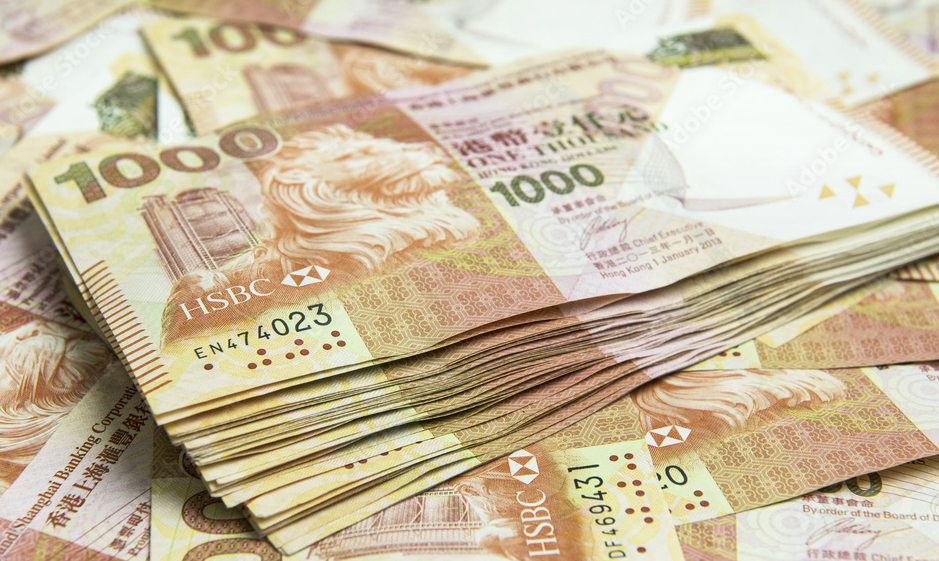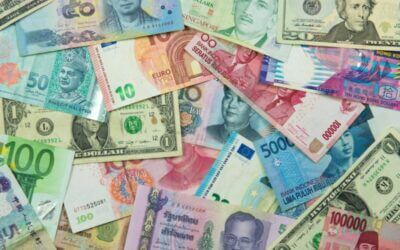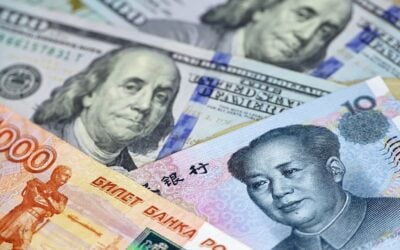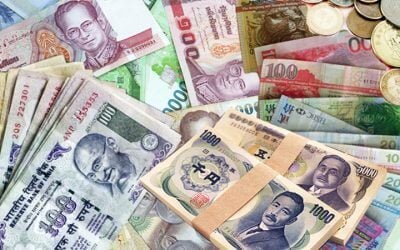In a world increasingly dominated by digital transactions and cryptocurrency, the concept of high-value banknotes might seem like a relic of the past.
However, they still hold significance, whether for facilitating large transactions, serving as a store of value, or simply representing a nation’s economic pride.
When we talk about the largest value banknotes, we refer to their face value in the local currency. But their real-world value depends on factors like exchange rates, purchasing power, and their role in the broader economy.
The World’s Largest Value Banknotes
High-value banknotes are often designed for large financial transactions, typically used by banks, businesses, or wealthy individuals. They’re also a favorite topic in discussions about the future of cash.
From the towering denominations of Singapore and Brunei to the solid reliability of Swiss Francs, let’s explore the largest value banknotes currently in circulation, their uses, and what they mean for global finance.
Singapore Dollar (SGD 10,000)
For a long time, Singapore held the record for the highest-value banknote in circulation, with the SGD 10,000 note.
This note, equivalent to about $7,400 USD, was primarily used for significant financial transactions.
Yet in a bid to mitigate money laundering and terrorism financing risks, the Monetary Authority of Singapore retired its issuance in 2014.
While no new SGD 10,000 notes are being printed, those still in circulation remain legal tender and can be used for payments.
Interestingly, Singapore also issued a $1,000 note, which remains available but is less frequently used.
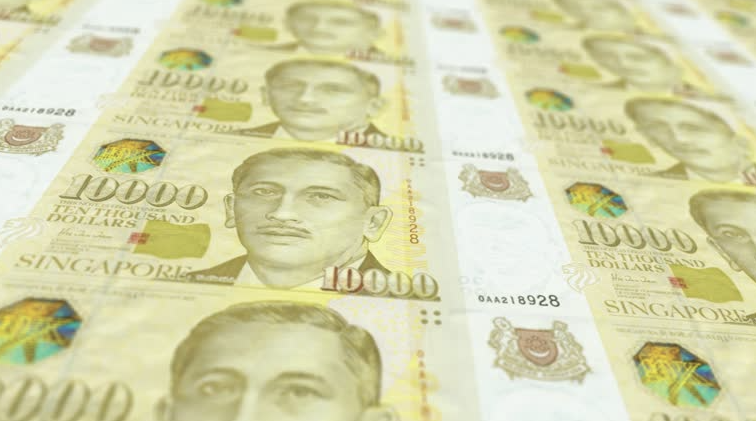
High value notes such as the SGD 10,000 and 1,000 are not regularly used in Singapore anymore, thanks to the arrival of advanced fintech and banking systems.
As Singapore continues to modernize its financial systems, the role of high-value cash is diminishing, but the country’s pragmatic approach ensures these notes still serve their intended purpose.
Brunei Dollar (BND 10,000)
Brunei’s BND 10,000 note is another notable heavyweight, valued at approximately $7,500 USD.
Thanks to a currency interchangeability agreement with Singapore, the Brunei Dollar is pegged to the Singapore Dollar, allowing both currencies to be used interchangeably.
This unique agreement means that Brunei can continue issuing its BND 10,000 note even as Singapore phases out its equivalent.
Brunei’s oil-rich economy provides a stable foundation for its currency, ensuring that the BND 10,000 note remains a practical tool for high-value transactions.
However, Brunei’s currency usage is largely limited to institutional settings, as the average consumer rarely encounters such high denomination bills in daily life.
Swiss Franc (CHF 1,000)
Switzerland bucks the global trend of phasing out high-value banknotes by maintaining its CHF 1,000 note, valued at around $1,102 USD.
This purple-colored note is not only a symbol of Swiss precision but also a practical tool in a country where cash is still widely used.
Remarkably, about half of all Swiss cash in circulation is held in CHF 1,000 notes, highlighting their importance as a store of value.
The Swiss government has consistently defended the CHF 1,000 note against criticism, arguing that its size has minimal impact on criminal activity.
For investors and collectors alike, the note represents both stability and a touch of luxury.
Armenian Dram (AMD 100,000)
Armenia, a small but historically rich country, issues one of the world’s largest value banknotes: the AMD 100,000 note.
Valued at around $250 USD, this note primarily exists due to the high conversion rate of the Armenian Dram, which is approximately 500 AMD to 1 USD.
The note features imagery of historical figures, adding a cultural dimension to its economic utility.
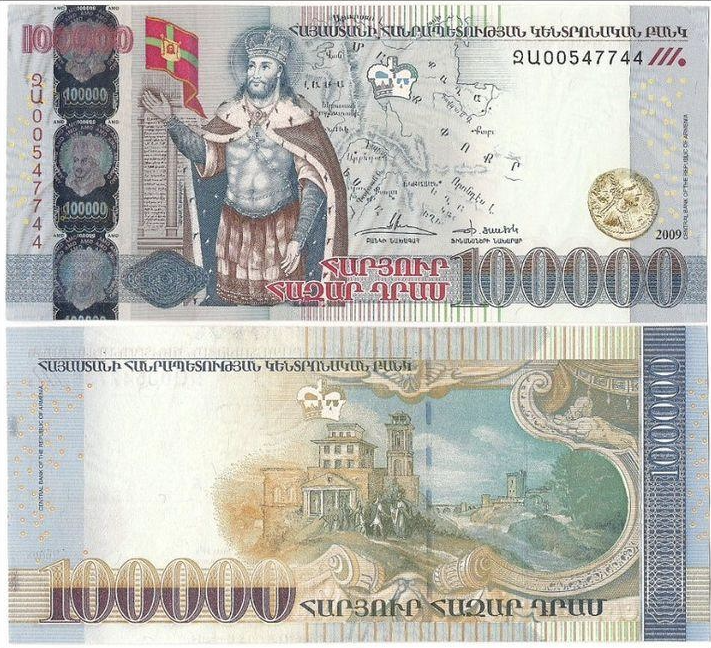
The beautiful AMD 100,000 note features King Abgar V of Edessa, believed to be one of the first Christian kings.
While the high value dram note is still in circulation, Armenia’s central bank hasn’t included it in newer series of banknotes, raising questions about its future availability.
Hong Kong Dollar (HKD 1,000)
The HKD 1,000 note, valued at approximately $130 USD, may not seem like much compared to others on this list, but it plays a vital role in Hong Kong’s economy.
Pegged to the US dollar, the Hong Kong Dollar benefits from sound monetary policies, making it a reliable currency for both domestic and international transactions.
What sets the HKD 1,000 note apart is its potential future. As Hong Kong’s economic alignment with China grows, there’s speculation that the currency could eventually peg to the Chinese Renminbi, potentially increasing its value significantly.
Unless that happens though, the Hong Kong Dollar is essentially the same currency as the USD without the flexibility.
The War on Cash: Will High-Value Banknotes Survive?
Around the globe, the use of cash is on the decline. Digital banking, mobile payments, and the rise of Central Bank Digital Currencies (CBDCs) are reshaping the financial landscape.
High-value banknotes are often the first to be targeted in efforts to combat money laundering and tax evasion.
For example, the United States discontinued its $1,000 and $10,000 notes decades ago, and the Eurozone stopped issuing the €500 note in 2019.
While some regions, like Europe and the US, are moving away from cash, others, such as the Middle East and parts of Asia, still embrace it.
In the UAE, for instance, the AED 1,000 note remains a common sight, reflecting the region’s cash-friendly culture.
High-Value Banknotes Matter: Why Does it Matter?
For investors and global citizens, high-value banknotes are more than just currency—they’re tools for wealth management and symbols of economic stability. Here’s why they remain relevant:
- Facilitating Large Transactions: High-value notes make it easier to conduct significant transactions without requiring bulky stacks of cash.
- Store of Value: In countries with stable currencies like Switzerland, high-value banknotes are often used as a store of wealth.
- Cultural and Historical Significance: These notes often feature intricate designs and historical figures, making them valuable to collectors.
As governments push toward digital currencies though, the future of high-value banknotes is uncertain. For now, they continue serving as a fascinating intersection of finance, culture, and history.
The largest value banknotes in the world offer a glimpse into the diverse ways countries manage their monetary systems.
From the SGD 10,000 note in Singapore to the CHF 1,000 note in Switzerland, these high-value bills reflect the unique economic and cultural contexts of their nations.
As the world shifts toward digital payments and CBDCs, the role of high-value banknotes may diminish, but their historical and practical significance remains undeniable.
So whether you’re an investor, collector, or simply curious about finance, understanding these banknotes provides valuable insights into the broader economic landscape.
After all, in a world of fleeting digital transactions, there’s something reassuring about the weight of a well-designed, high denomination bills in your hands.
FAQs: Biggest Currency Notes in the World
What's Largest Value Banknote Currently in Circulation?
The largest value banknote in circulation is the 10,000 Brunei Dollar (BND), which is equivalent to approximately $7,500 USD as of 2025.
This note is issued by the Monetary Authority of Brunei Darussalam and is interchangeable with the Singapore Dollar due to a longstanding currency agreement.
Does the United States Still Have an $1,000 Bill?
No, the United States discontinued its $500, $1,000, $10,000, and $100,000 bills back in 1969.
Today, the largest denomination in circulation is the $100 bill. There has also been recent discussion about potentially removing the $100 bill from circulation.
What's the Weakest Currency in the World?
Currently, the Iranian Rial is the weakest currency in the world. One Iranian Rial is now valued at approximately $0.000024 USD.
How Many Currencies Are in the World?
Currently, the United Nations recognizes 180 currencies which are used and circulated in 195 countries worldwide.

